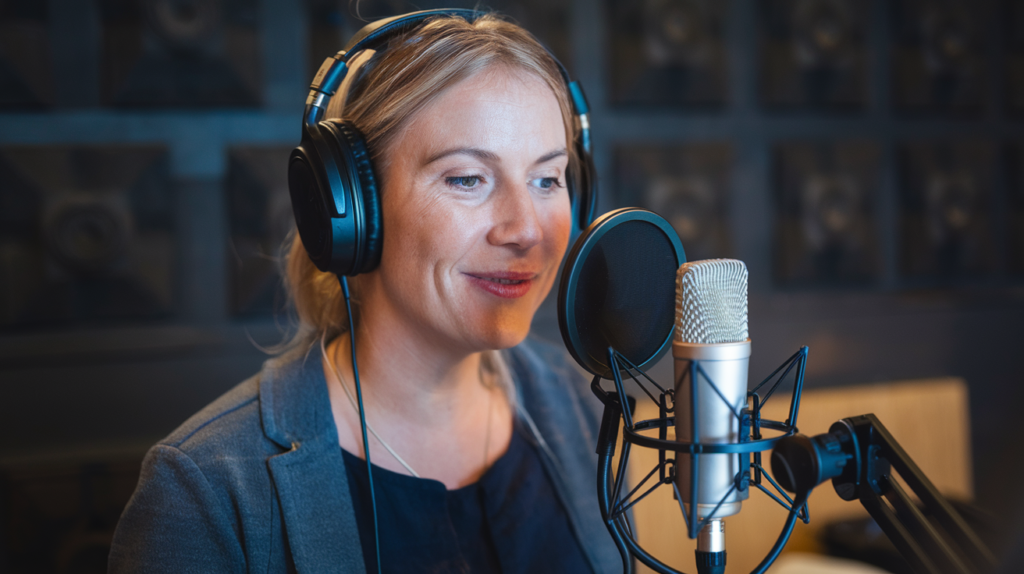Key Takeaways
- Understanding New Zealand English: Familiarize yourself with the unique vowel sounds, slang, and Māori terms that characterize NZE to enhance voiceover effectiveness.
- Synchronization Importance: Proper syncing of voiceovers with visuals is crucial for audience engagement and effective communication, especially when reflecting regional nuances.
- Cultural Relevance: Incorporating local slang and expressions in your voiceovers not only enriches content but also demonstrates respect for cultural diversity.
- Audio Alignment Strategies: Use clear audio alignment techniques, such as adjusting waveforms and marking cue points, to create a cohesive experience between audio and video.
- Timing & Pacing Considerations: Pay attention to NZE’s unique rhythm patterns and emotional beats within scripts for impactful synchronization that resonates with viewers.
- Utilizing Tools & Hardware: Choose appropriate software like Adobe Audition or Audacity, and invest in quality microphones and interfaces to achieve optimal voiceover results.
Ever struggled with syncing New Zealand English voiceovers to your projects? You’re not alone. Many creators face the challenge of ensuring that audio and visuals align seamlessly, especially when dealing with regional accents and dialects.
Understanding New Zealand English
New Zealand English (NZE) has distinct characteristics that set it apart. Familiarity with these features enhances the effectiveness of voiceovers, especially when targeting local audiences.
Unique Features of New Zealand English
New Zealand English is known for its unique vowel sounds and specific slang. For instance, the short „i“ in words like „fish“ can sound more like „fush.“ This pronunciation can be crucial for voice artists aiming to resonate authentically with Kiwi audiences. Additionally, NZE incorporates Māori terms and phrases, enriching the language’s expressiveness. Recognizing this blend helps voice actors deliver lines naturally.
Differences from Other English Variants
NZE differs significantly from other variants like Australian or British English. The rhythm and intonation patterns vary, influencing how a voiceover artist should approach their delivery. While both NZE and Australian English may share some similarities, subtle differences in tone can create misunderstandings if not handled properly. For instance, where Australians might say “no worries,” Kiwis often say “sweet as.” Such nuances matter when trying to connect through audio content.
Understanding these elements makes syncing New Zealand English voiceovers smoother and more effective in engaging your audience authentically.
The Importance of Voiceover Syncing
Voiceover syncing plays a crucial role in creating engaging content that resonates with your audience. Accurate alignment of audio and visuals ensures that the message comes across effectively, especially when the voiceover reflects regional nuances.
Enhancing Audience Engagement
Engaging your audience relies heavily on how well you sync your voiceovers with the visuals. When done right, this synchronization captures attention and enhances comprehension. A natural-sounding voice over can evoke emotions and create connections, making viewers more likely to engage with the content. Think about it—when a voice artist delivers lines that match the action on screen, it draws viewers in and keeps them invested in the story.
Cultural Relevance in Voiceovers
Cultural relevance is key for effective communication. New Zealand English includes unique slang, vowel sounds, and expressions that resonate with local audiences. Using these elements makes your project feel authentic and relatable. A skilled voice actor familiar with these subtleties can elevate your content by incorporating Māori terms or culturally significant phrases seamlessly into their delivery. This not only enriches the narrative but also shows respect for cultural diversity—something audiences appreciate greatly.
By prioritizing proper syncing of New Zealand English voiceovers, you enhance both engagement and cultural connection within your projects.
Techniques for Syncing New Zealand English Voiceovers
Syncing New Zealand English (NZE) voiceovers requires specific techniques to ensure audio aligns seamlessly with visuals. Understanding the nuances of NZE can enhance your project and engage your audience more effectively.
Audio Alignment Strategies
Focus on clear audio alignment to create a natural flow between spoken content and visual elements. Start by ensuring that your audio track matches the timing of the visuals precisely. Use editing software to adjust the waveform, shifting segments as needed. You might also consider employing a metronome or click track during recording sessions; this helps maintain consistent pacing throughout the performance.
Another effective strategy involves cue points, where you mark significant moments in both audio and video tracks. By aligning these cues, you create a more cohesive experience for viewers. Additionally, being aware of regional accents and dialects enhances authenticity—using local slang and expressions can deepen engagement.
Timing and Pacing Considerations
Timing is crucial when syncing NZE voiceovers with visuals. Pay attention to rhythm patterns unique to NZE; they differ from other English variants like Australian or British English. A good practice is to listen closely to how native speakers phrase sentences—this insight informs pacing decisions when working with voice actors or artists.
Consider emotional beats within your script. Align these moments with visual cues for maximum impact; an emotionally charged line deserves an equally powerful image. Lastly, allow room for pauses in dialogue—these are essential for comprehension and provide breathing space for audiences to absorb information.
By focusing on these techniques, you can elevate your projects through precise syncing of NZE voiceovers while resonating authentically with Kiwi audiences.
Tools and Software for Effective Syncing
Syncing New Zealand English voiceovers requires the right tools and software to ensure a smooth alignment between audio and visuals. Choosing effective options can significantly enhance your projects.
Recommended Voiceover Software
Select voiceover software that caters specifically to syncing needs. Popular choices include:
- Adobe Audition: This powerful editing tool allows precise adjustments of audio timing, making it easier to align voiceovers with video.
- Audacity: A free option that offers essential features for recording and editing tracks, helping you achieve clear sound quality.
- Reaper: Known for its flexibility, Reaper provides extensive customization options, perfect for detailed syncing tasks.
- Final Cut Pro X: Ideal for video editing, this software integrates robust audio solutions that simplify voiceover syncing.
Consider using tools with built-in metronomes or click tracks. These features help maintain consistent pacing during recordings, ensuring your voice actor captures the rhythm of NZE effectively.
Hardware Considerations
Investing in quality hardware is crucial for achieving optimal results in voiceover work. Here are some key components to consider:
- Microphone: Select a high-quality microphone suited for voice recordings. Options like condenser microphones often capture nuances in vocal tone better than standard ones.
- Audio Interface: An interface enhances sound input quality by converting analog signals into digital formats without loss of fidelity.
- Headphones: Use closed-back headphones while recording to prevent audio bleed and maintain focus on the task at hand.
- Acoustic Treatment: Create a controlled environment by minimizing background noise through soundproofing measures or using portable vocal booths.
With the right combination of software and hardware at your disposal, you can elevate your NZE voiceovers’ effectiveness while ensuring they resonate authentically with Kiwi audiences.
Conclusion
Mastering the art of syncing New Zealand English voiceovers unlocks a new level of engagement in your projects. By embracing the unique characteristics of NZE including its distinct accents and cultural nuances you create content that truly resonates with Kiwi audiences.
Utilizing the right tools and techniques not only enhances audio-visual alignment but also enriches the storytelling experience. Remember to focus on pacing rhythm and emotional beats to ensure your voiceovers sound as natural as possible.
Investing in quality equipment further amplifies your results allowing for clearer audio and a more immersive viewer experience. With dedication to these practices you’ll elevate your content making it both relatable and impactful.
Frequently Asked Questions
What is New Zealand English (NZE) voiceover?
NZE voiceover refers to narration or dialogue performed in the distinct accent and dialect of New Zealand English. It features unique vowel sounds, slang, and incorporates Māori phrases, making it essential for creators to resonate authentically with Kiwi audiences.
Why is syncing important for NZE voiceovers?
Syncing is crucial because accurate alignment of audio and visuals enhances audience engagement. Properly synced content improves comprehension and emotional connection, ensuring the message resonates more effectively with viewers.
What challenges do creators face when syncing NZE voiceovers?
Creators often struggle with aligning the rhythm and intonation patterns of NZE voiceovers to their projects. The distinct characteristics of NZE can create difficulties in achieving a natural flow between spoken content and visuals.
How can I improve my NZE voiceover syncing skills?
You can improve your syncing skills by using editing software to adjust audio timing, employing metronomes during recording for consistent pacing, and marking cue points in both audio and video tracks for better alignment.
What tools are recommended for syncing NZE voiceovers?
Recommended tools include Adobe Audition, Audacity, Reaper, and Final Cut Pro X. Investing in high-quality microphones, audio interfaces, closed-back headphones, and acoustic treatment also significantly enhances the quality of your recordings.
How does cultural relevance affect NZE voiceovers?
Cultural relevance is key as incorporating local slang and expressions makes projects feel authentic. Using culturally significant phrases demonstrates respect for diversity while enhancing viewer relatability and engagement.







